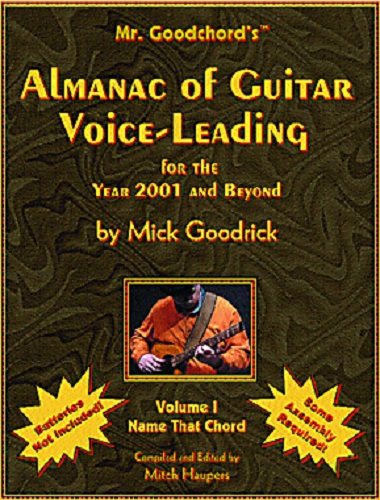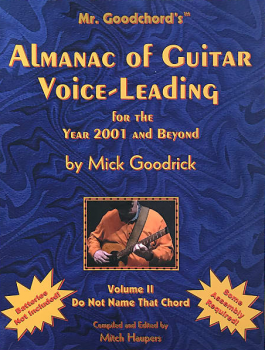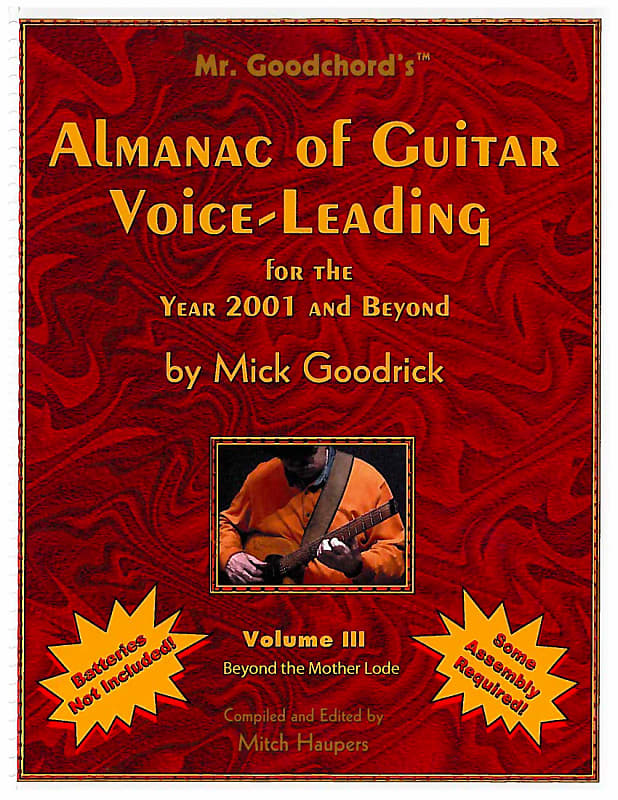Table of Contents
Review: “Almanac of Guitar Voice-Leading”
“Almanac of Guitar Voice-Leading” is perhaps one of the most important book ever written about guitar chords and voice leading. The information presented is priceless. Let’s take a look.
Almanac of Guitar Voice-Leading Vol 1

Mick Goodrick is well known for writing interesting, humorous, and informative instruction books for guitar. The “Almanac of Guitar Voice-Leading for the Year 2001 and Beyond” should be considered his magnum opus. The depth of this book cannot be overstated – for the serious player this is THE book on chords and voice-leading.
Table of Contents
Goodrick’s humor comes through right from the start, as the contents include sections named, “Disclaimer/Warning/Caution”, “What is This Book?”, and “It Would Seem That Some Things Are Missing”.
The actual chord sections are designated by Triads, 7th Chords, Triads Over Bass Notes 1 and Triads Over Bass Notes 2.
The Triad section is further subdivided by Closed and Spread Triads, 6 Cycles and the keys of C Major, C Melodic Minor and C Harmonic Minor.
The other non-Triad sections are similarly laid out, with the exception of 6 various Voicing Types replacing the “Close and Spread” voicings of the Triad section.
Disclaimer/Warning/Caution!!!
This section deals with a very important topic when covering material such as this – being very careful, as physical pain/discomfort/injury are all in play here, and it is easy for someone to push themselves too hard, too fast. Whenever you are dealing with “exotic” chord voicings with large stretches, there is the risk of injury, and Goodrick does his best to instill the fear of God into you, so that you don’t hurt yourself. Take heed.
What is This Book?
Goodrick claims that this is a “guitar sourcebook”, which is a fairly accurate statement. He gives a concise overview of the material contained within, as well as explaining about chords and voice leading, and how they will improve your playing in other areas.
It Would Seem That Some Things Are Missing…
To quote, Goodrick, “Correct. Much is missing. In fact, almost everything that one would deem important is missing!”. He then lists several “obvious” things that are missing, including, “Detailed instructions on what to do”.
The “premise” of the book is that the user will work out what they feel they need to work on and discover all of the “necessary” things on a more personal level. You will find yourself understanding things that you previously didn’t quite grasp, while at the same time, someone else will be comprehending something entirely different.
This is a very personal book and each user will most likely come away with something different, though clearly related.
Name That Chord
As far as instruction goes, this is the section that you must pay special attention to, as this is where Goodrick drops general hints and approaches pertaining to the book.
The layout is in a “Question and Answer” format. As you work through the book you will probably return to this section to revisit some of the “theoretical” musings and see how you relate to them at your present level.
Goodricks humor is once again on display as he purposely tries to give direct answers to specific questions. After all, how can you discover something on your own, if you are told the answers upfront.
Layout
The entire book is laid out in the following manner:
Header Section:
Chord Family: This will be either a Triad, 7th, or Triad Over Bass Note
Voicing Type: This will list the specific voicing used in that example
Scale: This will be either C Major, C Melodic Minor or C Harmonic Minor
Cycle: This indicates how the chords will move.
The various Cycles are: 2, 4, 6, 7, 5 and 3
Example: Cycle 3 for 7th chords = Cmaj7, Em7, G7, Bm7b5, Dm7, Fmaj7 and Am7. (Chords moving by thirds)
Intervallic Voice Leading: This shows how each of the voices move in the chord, designated by intervals. Example: The Close Triad Voicing has the 5th moving down a 2nd, the 3rd moving down a 2nd and the Root moving down a 3rd. This pattern carries through the entire example.
Functional Voice Leading: This diagrams out the movement of the voices. Example The Close Triad pattern mentioned above moves in the following manner; the 5th moves to the 3rd, the 3rd moves to the Root and the Root moves to the 5th. This pattern repeats itself.
There is also a diagram showing arrows pointing to how the voices move.
At the bottom of each page is the M.S.R.P section. This stands for Melodic Strand Replication Procedure, and is related to the Intervallic/Functional Voice Leading section above, but approaches it in a more melodic manner. This primarily deals with the melodic nature of the voice movements.
The middle of the page is the main focus of the voice movements and is clearly written out in “diagram” form. There is no notation or tab. The letters of the notes of the chord are “stacked” and arrows are used to designate the movement. An important note is that there is no indication of octaves. You can chose a low “C”, a mid “C”, whatever you like. As a matter of fact you will probably want to experiment with different octave usage, as it will reveal several nice voicings that you might not have discovered independently.
On a personal note, since I play a Hybrid Guitar, I voice the lowest note of each chord on one of the bass strings, while voicing the other notes of the chord on the guitar strings. The sound of the voicings are incredible, as they sound beautiful and full, with a wide spread of sound – more like a piano or guitar/bass duo, rather than a just a solo guitar.
Triads, Close & Spread, All Cycles: C Major, C Melodic Minor, C Harmonic Minor
Each page of the Triad section contains both the Close and Spread voicings. Since there are three notes in each chord, there are three sections that flow together and are repeated. Each one of the sections starts on a different note of the triad.
Lots of good stuff contained here, however, if you have limited time to practice, I would suggest that you browse through this section of the book and then quickly move onto the 7th chord section.
7th Chords, All Cycles: C Major, C Melodic Minor, C Harmonic Minor
Although this section of the book is laid out in a similar manner as the triadic section, there are some significant differences.
For one thing, now that there are four notes to a chord, there are now four sections that flow together and are then repeated. Each of the sections starts on a different note of the 7th chord.
Another thing, each of the harmonic sections is broken down into more variations than the “Close and Spread” of the triadic section.
For example, EACH cycle is presented with the following voicing types: 4-Way Close, Drop 2, Drop 3, Drop 2 & 3, Drop 2 & 4 and Double Drop 2 Drop 3.
There is a very significant increase in the amount of information contained in this section of the book compared to the triadic section.
Triad over Bass Notes 1, All Cycles: C Major, C Melodic Minor, C Harmonic Minor
This section is laid out in a similar manner to the aforementioned 7th chord section.
Triad over Bass Notes 2, All Cycles: C Major, C Melodic Minor, C Harmonic Minor
This section is organized in the same manner as the “Triad over Bass Notes 1” listed above.
Almanac of Guitar Voice-Leading Volume 2

As if the first volume of the series wasn’t enough, Goodrick continues his madness with a second volume dedicated to Quartal Harmony, named “Do Not Name That Chord”.
Not surprisingly, the book is laid out in a similar manner as volume 1. The harmonic difference being the focus on “3-Part 4ths”, “4-Part 4ths” and “Spread Clusters”. 265+ pages of additional madness! A gold mine for those interested in Quartal Harmony.
Although the material is excellent, I find myself focusing more on the first volume and occasionally opening this one for the times where I’m in the mood to explore these types of sounds. Nevertheless, if you are into this type of harmony, then perhaps you might want to start here.
Almanac of Guitar Voice-Leading Volume 3

I’ve never seen a copy of this, however, there is a “coming soon” listed within volume two of the series and it states the following: “Name that Chord”, “3-Part Chords”, “Ways of the M-Lode”, “Flavor of the Month”, “Melodic Embellishment”, “Declassified Information”, “More Ways of the M-Lode”, “Tonic Systems”, “Grip-Slipping”, “The Dark Night of the Chord”, “Looking Ahead”.
Your guess is as good as mine as to what the above material is like. I’m sure that it is interesting, as I wouldn’t expect anything less from Goodrick, but nevertheless, I have no interest in spending a couple of hundred dollars to find out, as there is so much material in volumes one and two, that I can’t even imagine trying to add what volume 3 has to offer… LOL 🙂
Perhaps one day I’ll stumble across a copy and see if it is worth it. Or maybe it will come back in print and I can assess it at a reasonable price.
Summary
I still don’t understand why this series of books are out of print. I consider these books to be the perhaps the most important books written for guitar voicings and voice leading. The concept is brilliant, and like other important tomes (Van Eps, “Harmonic Mechanisms” vol 1-3), there is more information contained within that you could ever try to memorize in a lifetime!
This is not a “linear” book, meaning that you can open up to any page/section and begin to explore. And while some of the voicings are downright gorgeous, there are also some voicings that you will probably find too uncomfortable to use. This is not a book for the meek. This is a serious tome that demands the student to explore and grasp the concepts and stumble across some nice voicings and voice movement. It is NOT meant to be completely memorized, you will find material that will prove to be useful for your playing and harmonic knowledge, and add them accordingly. There is far too much substance to try and conquer it all.
And while I was at first, a bit disappointed, that Goodrick didn’t go more in depth on the approaches and concepts contained within, I do respect and agree with the approach of going through the material and learning things on your own. It will yield a more personal approach to your chord voicings and have an impact on how you compose and play.
Every time I open up to any of the 375+ pages of Volume 1, I learn something new. Volume 2 is a nice harmonic change of pace. There are many nuances and concepts that you will discover along the way. This is a book that I wish I had 40 years ago, so that I could have spent decades delving into its secrets.
Very Highly Recommended
Final Words
As always, I’d like to take a moment to thank everyone who has purchased my book! I appreciate your interest and support and I look forward to hearing what you do with the material!
I’ve again enclosed a recent master study drawing that I did of Frank Frazetta’s painting, “Princess of Mars”, using Procreate on an iPad Pro, with an Apple Pencil 2.






0 Comments